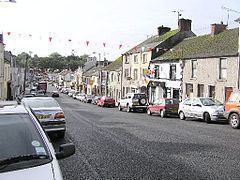Population 642 (2001) Sovereign state United Kingdom Province Ulster | Irish grid reference H630574 Local time Wednesday 2:51 AM Dialling code 28 | |
 | ||
Weather 2°C, Wind W at 10 km/h, 94% Humidity | ||
Ballygawley or Ballygawly (from Irish: Baile Uí Dhálaigh, meaning "Ó Dálaigh's townland") is a Town in County Tyrone, Northern Ireland. It is about 13 miles southwest of Dungannon, near the meeting of the A5 Omagh–Monaghan and A4 Dungannon–Enniskillen roads.
Contents
- Map of Ballygawley Dungannon UK
- Geography
- History
- The Troubles
- People
- Development
- Events
- Transport
- Education
- Sport
- 19th century population
- 21st century population
- Ballygawley Townland
- References
Map of Ballygawley, Dungannon, UK
Geography
An American visitor in 1925 commented on the way the village was laid out: "...Ballygawley, which I found to be a village or settlement on two streets (or possibly on one street which turned at right angles to my left as I stood looking at the buildings when I came in sight of the place). It was a wide street, with excellent cement sidewalks not very wide, and the buildings came up flush with the sidewalks, and there were no alleys, driveways or paths between the buildings."
It is a compact village around the ‘L’ shaped Main Street and Church Street,formerly Meeting House Street, with a second cluster of development to the southwest. The main cluster inholds most of the village’s facilities; two primary schools, churches and a range of shops and services. The cluster of development to the southwest inholds a secondary school and housing. Ballygawley had a population of 642 at the 2001 Census.
History
Ballygawley is also known as "Errigal-Kerogue" or "Errigal-Kieran", supposedly from the dedication of an ancient church to St. Kieran (Ciarán of Clonmacnoise). It was in the Clogher (barony), along the River Blackwater, Northern Ireland. Some of the remains of the old church were known, and an ancient Franciscan friary, founded by Conn O'Neill, 1st Earl of Tyrone. In the churchyard was a large stone cross, and a holy well.
The Troubles
For more information see The Troubles in Ballygawley, which includes a list of incidents in Ballygawley during the Troubles resulting in two or more fatalities, as well as:
People
Development
Ballygawley is acquiring extensive development with the major upgrade to the A4 and the building of the new roundabout to accommodate the traffic congestion from the main Aughnacloy, County Tyrone rd. With these road improvements many contractors have been submitting plans for extensive housing developments. The most exciting of all being the redevelopment of Main st leading onto Church Street, with plans for new bars and restaurants. There is speculation of the Stewart Arms hotel being reopened and other developments such as the health spa at 'Grangemount'. There are other developments such as the rebuilding of Loughrans Castle as a historical building to house historical items from the surrounding area. The Ballygawley River is a major tourist attraction supplying the finest of fresh water fishing in Ireland. The original hydo-electric station at the old Dungannon rd is being rebuilt to provide a large amount of the town's energy.
Events
Although having an Irish nationalist majority, Ballygawley is paraded through by the unionist loyal orders without any incident and last held the Orange Orders "Twelfth" celebrations in 2006, and the Royal Black Institutions "Black Saturday" demonstration in 2011.
Outdoor activity centre Todds Leap is located in Ballygawley hosting various events and outdoor activities.
Transport
Education
Sport
19th century population
The population of the village decreased during the 19th century:
21st century population
Ballygawley is classified as a Small Village or Hamlet by the NI Statistics and Research Agency (NISRA) (i.e. with population between 500 and 1,000 people). In the 2001 census (29 April 2001) there were 642 people living in Ballygawley. Of these:
For more details see: NI Neighbourhood Information Service
Ballygawley Townland
It is situated in the historic barony of Clogher and the civil parish of Errigal Keerogue and covers an area of 123 acres.
The population of the townland declined during the 19th century:
The townland contains one Scheduled Historic Monument: a Castle (grid ref: H6324 5749).
